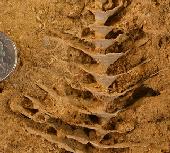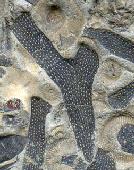|
 See More Images See More Images

Archimedes
© 2001 Richard Schrantz

Archimedes
© 2003 Thomas Kammer

Cystodictya
© 2003 Milwaukee Public Museum
|
What are Bryozoans? Bryozoans are also known as “moss animals” for their superficial resemblance to mosses. What we see as “a bryozoan” is really a colony made of many little units, each made up of the animal and its house. Bryozoans are closely related to the brachiopods. Both groups possess a unique feeding and respiratory organ called a lophophore, which looks a bit like a rubber band covered with tiny hairs. By moving the hairs, they generate a current that brings water and food particles to the animal. Most bryozoans live attached to a hard surface, such as mussels, rocks, wood, sea turtle shells, or large algae. Many Paleozoic bryozoans built strong colony skeletons of calcium carbonate and are common fossils. First known fossil occurrence: Ordovician. Last known fossil occurrence: Quaternary. This group has living relatives. |
Fossils through time:
Choose a time period to see what life was like:
|
|